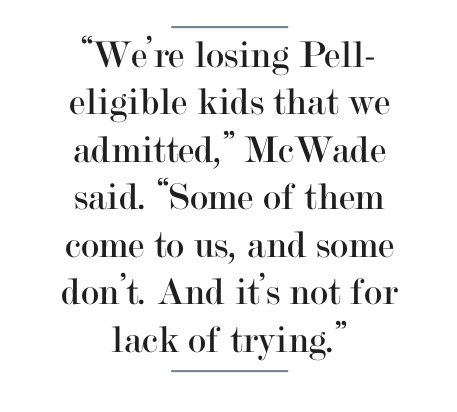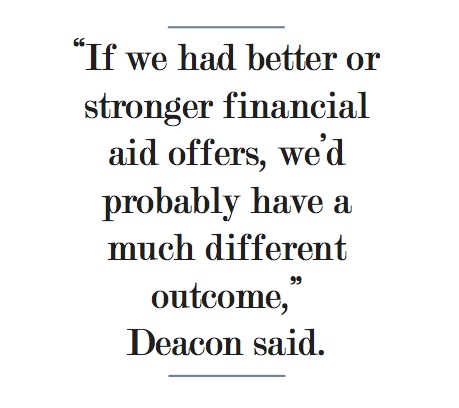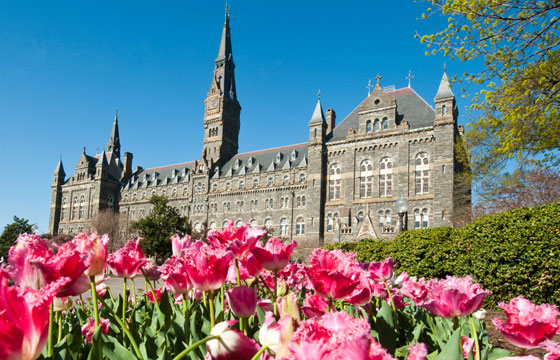Inherent in Jesuit educational values is a focus on providing premier academics to all students, regardless of background.
“There is deeply rooted in the Jesuit tradition a commitment to merit over accident or good fortune of birth,” said Vice President for Advancement Bart Moore (SFS ’87).
Moore explained that at the first Jesuit university in Messina, Italy, wealthy students helped subsidize the cost of the poorer students. “This is deeply engrained in our DNA,” he added.
However, Georgetown, the oldest Catholic and Jesuit university in the United States, was only the 88th most economically diverse and accessible university in the country in 2015 according to a New York Times ranking, and every year it loses top students to peer institutions like Harvard and Yale because it cannot offer as competitive financial aid packages for middle and low-income students, according to Dean of Student Financial Services Patricia McWade and Dean of Admissions Charles Deacon (COL ’64, GRD ’69).
While the ranking ignored Georgetown’s commitment to being need-blind in admissions and meeting the full need of domestic students – placing it on a select list of colleges with the ability to do so – Georgetown still enrolls fewer students receiving Pell grants as a percent of its student body than other schools that meet this same commitment, such as Harvard, Brown, Stanford, and Vassar.
The ranking factored in the price that middle- and low-income students pay, the size of the school’s endowment, and the percent of students receiving Pell funds.
A small federal scholarship of less than $6,000, Pell grants are typically awarded to students who demonstrate a high need in order to help cover the financial burden of college, McWade said. Although there is no income cutoff for Pell eligibility, she estimated that students who qualify have a household income of roughly $40,000 per year.
Only 13 percent of Georgetown students receive Pell grants, although McWade said more are admitted each year. The university’s reliance on loans in financial aid packages may deter them from choosing Georgetown, she said. “We’re losing Pell-eligible kids that we admitted,” McWade said. “Some of them come to us, and some don’t. And it’s not for lack of trying.”
Because of Georgetown’s commitment to being need-blind and meeting full need for domestic students, it cannot increase or decrease the total amount of aid it gives out after admitting a class, only the makeup of the aid, because that amount is dependent on how much aid the class needs. It may give a marginal amount of more scholarships in place of loans one year, but overall, the university commits to meeting the full need of the class regardless of how much that need is.
“The problem for us is we’re grouped with these other schools, happily at the top, and we’re like them or even stronger than them on many of the measures you would use to group them there, but one measure where we’re not in that group is an endowment,” Deacon said.

Because they have larger endowments on which they can rely more heavily to fund scholarships each year, peer schools like Harvard, Yale, and Princeton have eliminated loans from their financial aid offerings while still meeting the full need of students, according to their admissions and financial aid websites.
When determining aid packages, Georgetown makes up the difference between the expected family contribution and the amount of loans given out with scholarships, McWade explained. It also adds in Pell grants when students qualify, though they are small relative to Georgetown-funded scholarships.
The average size of a need-based Georgetown scholarship was $37,829 in the 2015 to 2016 academic year. On average, Georgetown students receive $3,000 to $5,000 per year in loans. Georgetown also expects its students receiving aid to work a part-time job earning around $3,000 per year, McWade said.
This reliance on loans hits lower and middle income families the hardest. Only 38 percent of accepted students from the middle income group actually enroll, Deacon said.
“If we had better or stronger financial aid offers, we’d probably have a much different outcome,” Deacon said.
The staff in the financial aid office and the admissions office is also smaller compared to peer schools, Deacon noted, and Georgetown cannot as aggressively recruit students or ensure that they complete their financial aid forms as others.
“Say we want to do what Harvard is doing, which is to add a lot staff and make a lot of focus on low-income students. And we want to ramp that up a lot higher than the normal, reasonable program we’re doing. We want to make it an exceptional plan. Probably wouldn’t be prudent for Georgetown to do that unless it had the ability to fund the need,” Deacon said.
Additionally, Georgetown continues to increase its tuition every year with plans to raise it at four percent per year over the next four years. In the 2015 to 2016 academic year, the average cost of attendance at the university hit $67,520, according to data from the Office of Student Financial Services.

While Deacon does not think that increasing tuition affects low-income, Pell-eligible students’ decisions to apply to Georgetown given that most of its peers have equally high costs of attendance, he said that its applicant pool is skewed toward wealthier students.
Deacon’s office will read around 22,000 applications this year, and he expects 10,000 to 15,000 applicants to come from wealthy backgrounds and only 3,000 to 4,000 to come from low-income backgrounds.
McWade, who does annual forecasts on how much aid Georgetown will need to give out, said that there is a consistency to Georgetown’s applicant pool each year. In her 25 years at Georgetown, she has never seen an unexpected change or increase in the number of students that would need aid.
If Georgetown did want to change the structure of its applicant pool and enrolling class, Deacon said it would affect the competitive nature of the school. “Georgetown does not want to drop down in ranks simply to be able to change the mix of students here. We want it to be at the top, and we want the very best of the lower income,” he added.
In order to attract low-income students, Georgetown currently works through what Deacon calls pipelines. These are organizations that help the university identify these students and support them as they apply to college as well as schools, such as the Cristo Rey network, which specifically educate low-income students.
According to Deacon, around 50 students who attend Georgetown went to Cristo Rey high schools, but he said many of these students struggle once they get here.
“They’re hard-working, great kids, but even for the top school kids in the Cristo Rey network, it’s a reach for them to come to Georgetown because the overall competitive nature of the university is a notch above most places,” Deacon said. If Georgetown wanted to admit more low-income students, Deacon said they would have to come from “farther down into the talent pool.”
While Georgetown has missed out on a pool of talented students due to its financial situation, it has recently begun working to aggressively increase its fundraising for scholarships, according to Moore whose office handles donations and capital campaigns.
Last year Georgetown raised $70 million for financial aid, and it has averaged $54 million per year since 2009. However from 2003 to 2008, Georgetown raised less than $11 million per year in aid, according to Moore.
The push came as a result of the prioritization of aid in the recently concluded For Generations to Come capital campaign, a fundraising effort focused on four target areas – scholarship and financial aid, faculty and academic excellence, community life, including facilities, athletics, and co-curricular activities, and improving existing programs within the university.
Although financial aid was the only category that fell short of its stated goal of $500 million, it still raised $429 million, the largest fundraising effort for scholarship in Georgetown’s history, Moore said. The $429 million includes undergraduate and graduate aid for current use gifts, meaning donations used to fund a specific scholarship once, and contributions to the university’s endowment.
Georgetown had never actively fundraised for aid as a high institutional priority until the recent campaign’s fourth year. Because of the economic downturn in 2008, the university identified $500 million in financial aid as a necessary fundraising target simply to meet its commitment to funding full need for students, Moore said.
The $429 million raised has allowed Georgetown to continue to meet its full-need commitment and modestly improve its financial aid packages, according to Moore.
Part of the reason that the university could raise the aid money was due to the fact that donations made to the main campus from the annual giving program without a specific purpose automatically went go to undergraduate aid, Moore said. In the past, it had been left to the discretion of the provost to divide these funds among faculty and research, financial aid, and student programs like athletics. Moore also said aid was the only publicly stated priority of the campaign for almost two years.
However, given Georgetown’s policy of meeting full need, Moore said donors sometimes do not think of financial aid when considering their gifts because their donation cannot increase the total aid amount of aid awarded and would only change the nature of the packages offered.
“It will feel like they are giving to a policy commitment rather than to a priority or to a person,” Moore said. “There are people with whom we have conversations about gifts or giving and they say, ‘So wait, you mean my gift is not going to result in $50,000 more financial aid being awarded in total at the university?’ And the answer to that is no, and that’s because of the logic of our meet full need commitment.”
Moore said having conversations with donors about giving to aid in order to increase scholarship and decrease loans has been productive to some extent, but it is ultimately up to the donor to decide where their money goes.
As the amount of gifts to aid increases, Georgetown can also lessen the impact that aid has on its current operating budget.
In 2016, 18 percent of Georgetown’s main campus expenses, or $122 million, went toward financial aid, according to data presented at the Hoya Roundtable on tuition and budgeting on Nov. 18. At the event, Provost Robert Groves said operating the more than $1.1 billion dollar university-wide budget is full of tradeoffs in trying to minimize tuition for students while still providing the services they demand.
“We’re attempting to improve Georgetown and the services you get, but it isn’t costless,” Groves said.
In recent years, one particular pressure students have placed on administrators has been facility maintenance. In the most recent campus plan, the university states renovating existing dorms as one of its priorities, in part due to student input in the planning process. In March 2015, GUSA released a petition asking the university to maintain existing buildings before starting new construction on campus.
The university also has legal obligations from the previous campus plan, which also puts a strain on its operating budget. As a result of the 2010 campus plan, 385 new beds were required on campus by fall 2015.
GUSA President Enushe Khan (MSB ’17) and Vice President Chris Fisk (COL ’17) did not respond to questions sent via email.
In order to fund new buildings, the university uses donations, its capital balances, or cash from the universities’ businesses after their expenses as well as yearly budget surpluses, and debt, Vice President of Finance and University Treasurer David Rubenstein wrote in an email to the Voice.
Pedro Arrupe Hall, for example, cost the university $46 million coming from the capital balances and debt, according to the university’s financial plan for 2017 to 2020.
In 2016, the university ran a $9.1 million surplus, its largest in the last four years. However, from 2003 to 2013, Georgetown operated with yearly deficits between $3.8 million and $23.9 million, according to data presented at the Hoya Roundtable on tuition.
These surpluses cannot help fund scholarships in place of loans because scholarships are a current expense, according to Rubenstein. If the university awarded the surplus to a scholarship in place of loans for an incoming student one year, it would have to ensure that the money still existed the following years to continue meeting that student’s full need.
If the university had a specific goal in mind, such as increasing by a certain percentage the number of students it enrolls who receive Pell grants, Deacon said that surpluses could be used to fund an endowment that could help meet that goal in the long run.
“Capital projects are great, and I’m glad they planted some pretty flowers over here – hopefully they’re permanent,” Deacon said. “But did we need the Thompson Center? I’m sure different people have different opinions, but I would say in the end if we’re committed to that area and we’re woeful in our athletic facilities, it was a good thing. Did we need as much of it as we got? That’s a question you could say, ‘Gee, could it have been done for less?’”
The $61 million Thompson Center, though largely funded by donors, relied on $12 million of debt and more than $7 million in capital balances.
Moving forward, the university has plans to increase its goal for financial aid fundraising to $750 million in its next capital campaign, Moore said.
One area that Deacon hopes to see a focus on is the Georgetown Scholarship Program (GSP) which supports 625 undergraduates, 70 percent of which are first generation college students, according to the program’s website.
After being accepted to the university, some students can qualify for the 1789 Scholarship–a special grant to replace part of a student’s loans by $3,000 per year. These students are also admitted to GSP, which works to support meeting their needs once at Georgetown by offering academic help, alumni connections, and general support in the students’ transition to a college campus.
Deacon said that Georgetown does not actively recruit students for this program, but it stands as one of the ways the university can become a more attractive option for low-income students due to the program’s success. Ninety-seven percent of GSP students graduate, according to the program’s website.
Deacon said that the university is currently working to endow the program, with $15 million of the $25 million goal already raised since last April.
“GSP is a model the university really needs to be using going forward for things other than scholarships so it doesn’t become a drain in the budget and a pressure on tuition,” he said.






